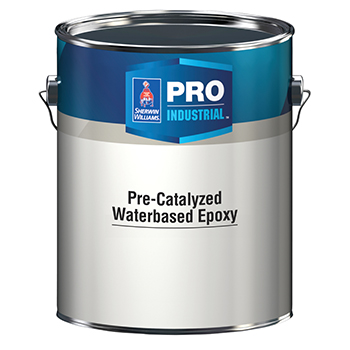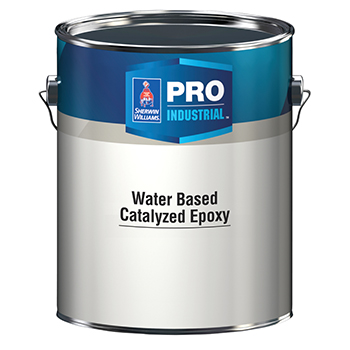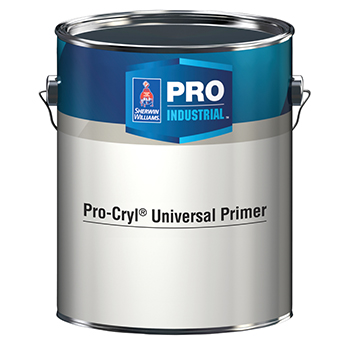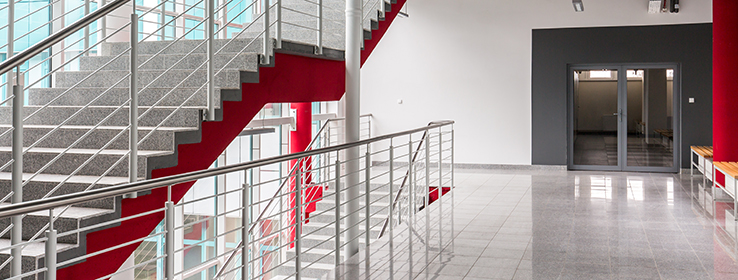Architects and commercial designers can meet or exceed green-building guidelines without sacrificing paint performance.
Whether it’s concrete, metal or composites, specifying paint for diverse substrates can be a challenge for architects and designers, especially as you strive to meet sustainable-building guidelines, including LEED. The good news is that recent developments in coating formulations can help you meet those challenges, providing easier application, improved durability and better performance, all while helping you meet the latest building standards.
One of the main innovations has been the conversion of many solvent-based coatings to water-based coatings. By reducing VOCs, these new formulas can help design pros meet their project goals.

For instance, Sherwin-Williams’ next-generation Pro Industrial™ Pre-Catalyzed Waterbased Epoxy is formulated to be washable, chemical-resistant, impact-resistant and durable, all in a single-component epoxy. It can be used on block, drywall, masonry, concrete and metals, and is perfect for high-traffic areas such as schools, hospitals and restaurants. With less than 50 g/L VOC, it’s UL GREENGUARD Gold–certified* and can be compared to some solvent-based epoxies for durability and the protection it provides through repeated cleanings. Since there’s no need to mix or measure, it also helps save time in application.

Pro Industrial™ Waterbased Catalyzed Epoxy is an interior two-component topcoat that can be applied directly to prepared steel, aluminum, galvanized and concrete substrates in industrial settings. It is corrosion-, abrasion-, moisture- and chemical-resistant but also has high color durability. It’s excellent for use in labs, schools, institutional kitchens, clean rooms, lavatories and USDA-inspected facilities. This formulation is also UL GREENGUARD Gold–certified* and comes in gloss and eg-shel finishes.

Another innovative, durable epoxy for floors is ArmorSeal® 8100. It’s a next-generation, water-based, two-component polyamine floor epoxy that has characteristics similar to our ArmorSeal® 1000 HS, a solvent-based floor epoxy, but this ArmorSeal 8100 formulation meets the most stringent VOC regulations and is UL GREENGUARD Gold–certified.* It can stand up to harsh chemicals and is breathable while being abrasion-resistant. It is self-priming over concrete and works well for warehouse floors, garages and light manufacturing plants. It is also acceptable for use in USDA-inspected facilities.

Yet another high-performance coating that is UL GREENGUARD Gold-certified*, Pro Industrial™ Pro-Cryl® Universal Primer is a water-based, self-cross-linking acrylic primer that’s rust-inhibitive and features less than 50 g/L VOC. It is corrosion-resistant and can be used as a primer under water-based or solvent-based topcoats in commercial, new construction and maintenance applications.
Challenging Substrates: Application Best Practices
When walking through a job site during the paint application process, there are things to look for to ensure substrates are being properly prepared.
“Cleaning dirt, grease, grime, rust and pollution from a surface is mandatory to take full advantage of a formulation’s properties,” says Rick Watson, Sherwin-Williams director of product information and technical services. “If a coating is sticking to surface contaminants and not to the substrate, it will simply blister and peel. So it’s very important to prepare the surface by cleaning, scraping and/or sanding to provide the topcoat with a good adhesion. Clean, dry, dull and sound. Plus, the temperature and humidity must be appropriate, too.”
*UL/GREENGUARD® Gold — Certified to UL/GREENGUARD® Gold standards for low chemical emissions into indoor air during product usage. To learn more, see UL.com/GG.
WARNING! Removal of old paint by sanding, scraping or other means may generate dust or fumes that contain lead. Exposure to lead dust or fumes may cause brain damage or other adverse health effects, especially in children or pregnant women. Controlling exposure to lead or other hazardous substances requires the use of proper protective equipment, such as a properly fitted respirator (NIOSH-approved) and proper containment and cleanup. For more information, call the National Lead Information Center at 1-800-424-LEAD (in U.S.) or contact your local health authority.





